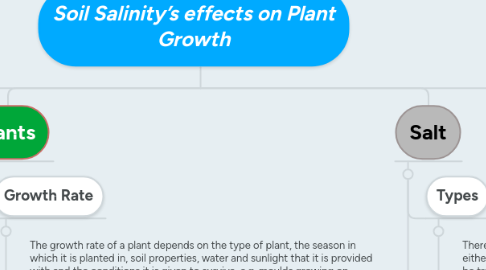
1. Plant Growth
1.1. Soil
1.1.1. The type of soil can affect the growth of the roots as well as the ability to absorb water and nutrients from the soil. This is seen in friable soil allowing roots to grow quickly, but inhibit the root to keep contact with soil to absorb the nutrients and water, vice versa for hard soils.
1.2. Water
1.2.1. Water is an essential part of the growth of plants, the amount of water required differs from the different species of plants.
1.3. Light
1.3.1. Light is the most important factor to plant growth as it is the factor that begins the process of photosynthesis in order for plant growth to occur. The amount of Light differs depending on the species of plant.
1.4. Temperature
1.4.1. The temperature that plants are exposed to can affect the growth of the plant as lower temperature slow down the photosynthesis process and thus slow down plant growth and plants produce lower yield. The same happens vice versa.
1.4.2. The soil temperature can also affect the germination of the plant as well as change the taste and texture of the fruit or produce that it yields.
1.5. Process
1.5.1. Plant growth is done through a process called photosynthesis in which the leaves of a plant draws in both light and carbon dioxide, whilst the roots absorb water, and turn those components into glucose, oxygen and water.
2. Salt
2.1. Types
2.1.1. There are many types of salts in the world. These can be either sea salts, rock salts or flavoured salts. Salts can even be treated to have other minerals in it such as iodised salt.
2.2. Collection
2.2.1. Salt is collected either through the evaporation of seawater or through salt mining
3. Plants
3.1. Growth Rate
3.1.1. The growth rate of a plant depends on the type of plant, the season in which it is planted in, soil properties, water and sunlight that it is provided with and the conditions it is given to survive, e.g. moulds growing on leaves.
3.2. Vegetables
3.2.1. Vegetables are seedless plants that are grown on vines, underground, in patches, or above ground. The time that these plants are sowed and harvested differs.
3.3. Fruits
3.3.1. Fruits are seeded plants that grow on trees, bushes, in patches, or on vines. Time of fruit harvest differs.
3.4. Edible vs. Non-Edible
3.4.1. Plants such as fruits, vegetables, sprouts, herbs and some fungi are edible.
3.4.2. Plants such as flowers, non-fruit bearing trees and houseplants such as ferns are not edible.
3.5. Season
3.5.1. The seasons determine when plants should be planted in order for the planter to obtain the best yield of produce or for the plant to bloom and grow correctly.
4. Soil Salinity
4.1. Dryland and Irrigation Salinity
4.1.1. Dryland salinity is when there is not enough native vegetation to keep water from leaking into the groundwater, lowering evaporation rates and raising the water table, bringing the stored salt with it.
4.1.2. Irrigation salinity is when irrigation is used in inappropriate places or is used improperly causing the ground to become waterlogged and eventually cause the water table to rise.
4.2. Where it Happens
4.2.1. Soil salinity occurs any places that he vegetation that is incapable of using natural water that is given to them, or in places where people use irrigation systems inappropriately.
4.3. How it Affects Plants
4.3.1. The salt levels in water make plants work harder to get the water required for them to grow, this could lead to plants dehydrating as they cannot absorb enough water to keep the plant growing as the effort to get the
4.3.2. Plants may also develop discoloured leaves, small fruits and slow stunted growth
4.4. How to Prevent
4.4.1. To prevent soil salinity, irrigation systems should be used correctly and in areas suitable for irrigation systems to be used, as well as the use of areas suitable for agriculture as to not cause dryland salinity due to the removal of plants that can use all the water they are provided with.
